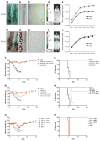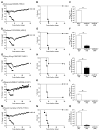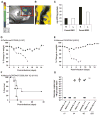Intranasal antibody gene transfer in mice and ferrets elicits broad protection against pandemic influenza
- PMID: 23720583
- PMCID: PMC4596530
- DOI: 10.1126/scitranslmed.3006299
Intranasal antibody gene transfer in mice and ferrets elicits broad protection against pandemic influenza
Abstract
The emergence of a new influenza pandemic remains a threat that could result in a substantial loss of life and economic disruption worldwide. Advances in human antibody isolation have led to the discovery of monoclonal antibodies (mAbs) that have broad neutralizing activity against various influenza strains, although their direct use for prophylaxis is impractical. To overcome this limitation, our approach is to deliver antibody via adeno-associated virus (AAV) vectors to the site of initial infection, which, for respiratory viruses such as influenza, is the nasopharyngeal mucosa. AAV vectors based on serotype 9 were engineered to express a modified version of the previously isolated broadly neutralizing mAb to influenza A, FI6. We demonstrate that intranasal delivery of AAV9.FI6 into mice afforded complete protection and log reductions in viral load to 100 LD₅₀ (median lethal dose) of three clinical isolates of H5N1 and two clinical isolates of H1N1, all of which have been associated with historic human pandemics (including H1N1 1918). Similarly, complete protection was achieved in ferrets challenged with lethal doses of H5N1 and H1N1. This approach serves as a platform for the prevention of natural or deliberate respiratory diseases for which a protective antibody is available.
Conflict of interest statement
Figures




Similar articles
-
The Hemagglutinin A Stem Antibody MEDI8852 Prevents and Controls Disease and Limits Transmission of Pandemic Influenza Viruses.J Infect Dis. 2017 Aug 1;216(3):356-365. doi: 10.1093/infdis/jix292. J Infect Dis. 2017. PMID: 28633457 Free PMC article.
-
Adeno-associated virus 9-mediated airway expression of antibody protects old and immunodeficient mice against influenza virus.Clin Vaccine Immunol. 2014 Nov;21(11):1528-33. doi: 10.1128/CVI.00572-14. Epub 2014 Sep 10. Clin Vaccine Immunol. 2014. PMID: 25209558 Free PMC article.
-
M2SR, a novel live influenza vaccine, protects mice and ferrets against highly pathogenic avian influenza.Vaccine. 2017 Jul 24;35(33):4177-4183. doi: 10.1016/j.vaccine.2017.06.039. Epub 2017 Jun 28. Vaccine. 2017. PMID: 28668565 Free PMC article.
-
In Vitro Neutralization Is Not Predictive of Prophylactic Efficacy of Broadly Neutralizing Monoclonal Antibodies CR6261 and CR9114 against Lethal H2 Influenza Virus Challenge in Mice.J Virol. 2017 Nov 30;91(24):e01603-17. doi: 10.1128/JVI.01603-17. Print 2017 Dec 15. J Virol. 2017. PMID: 29046448 Free PMC article.
-
An anti-H5N1 influenza virus FcDART antibody is a highly efficacious therapeutic agent and prophylactic against H5N1 influenza virus infection.J Virol. 2015 Apr;89(8):4549-61. doi: 10.1128/JVI.00078-15. Epub 2015 Feb 11. J Virol. 2015. PMID: 25673719 Free PMC article.
Cited by
-
Intranasal delivery of replicating mRNA encoding neutralizing antibody against SARS-CoV-2 infection in mice.Signal Transduct Target Ther. 2021 Oct 25;6(1):369. doi: 10.1038/s41392-021-00783-1. Signal Transduct Target Ther. 2021. PMID: 34697295 Free PMC article.
-
Circumventing cellular immunity by miR142-mediated regulation sufficiently supports rAAV-delivered OVA expression without activating humoral immunity.JCI Insight. 2019 May 21;5(13):e99052. doi: 10.1172/jci.insight.99052. JCI Insight. 2019. PMID: 31112525 Free PMC article.
-
Intramuscular Adeno-Associated Virus-Mediated Expression of Monoclonal Antibodies Provides 100% Protection Against Ebola Virus Infection in Mice.J Infect Dis. 2018 Mar 5;217(6):916-925. doi: 10.1093/infdis/jix644. J Infect Dis. 2018. PMID: 29365142 Free PMC article.
-
Adeno-associated virus: fit to serve.Curr Opin Virol. 2014 Oct;8:90-7. doi: 10.1016/j.coviro.2014.07.008. Epub 2014 Aug 13. Curr Opin Virol. 2014. PMID: 25128609 Free PMC article. Review.
-
Adenovirus delivery of encoded monoclonal antibody protects against different types of influenza virus infection.NPJ Vaccines. 2020 Jul 9;5(1):57. doi: 10.1038/s41541-020-0206-5. eCollection 2020. NPJ Vaccines. 2020. PMID: 32665862 Free PMC article.
References
-
- Stöhr K. Influenza—WHO cares. Lancet Infect Dis. 2002;2:517. - PubMed
-
- Mak PW, Jayawardena S, Poon LL. The evolving threat of influenza viruses of animal origin and the challenges in developing appropriate diagnostics. Clin Chem. 2012;58:1527–1533. - PubMed
-
- Rappuoli R, Dormitzer PR. Influenza: Options to improve pandemic preparation. Science. 2012;336:1531–1533. - PubMed
-
- Corti D, Voss J, Gamblin SJ, Codoni G, Macagno A, Jarrossay D, Vachieri SG, Pinna D, Minola A, Vanzetta F, Silacci C, Fernandez-Rodriguez BM, Agatic G, Bianchi S, Giacchetto-Sasselli I, Calder L, Sallusto F, Collins P, Haire LF, Temperton N, Langedijk JP, Skehel JJ, Lanzavecchia A. A neutralizing antibody selected from plasma cells that binds to group 1 and group 2 influenza A hemagglutinins. Science. 2011;333:850–856. - PubMed
Publication types
MeSH terms
Substances
Grants and funding
LinkOut - more resources
Full Text Sources
Other Literature Sources

